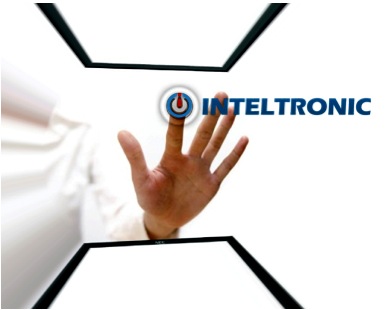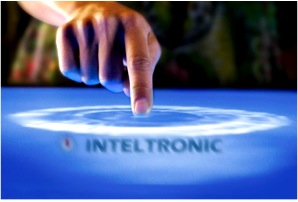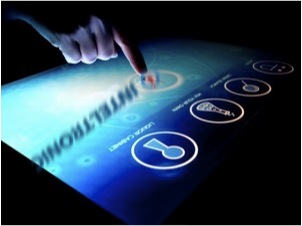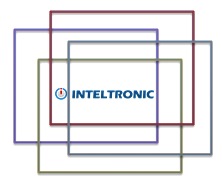Touch Panel
Inteltronic offers touch panels to match with your TFT modules. Touch screens are fast becoming the wave of the future, and the momentum doesn’t show any signs of slowing down. As software engineers continue to push for the most user-friendly interfaces, your fingers are quickly becoming the most powerful tools around you. Contact us for our touch panel products. See our Standard TFT with Integrated resistive touch panels. And TFT with Integrated capacitive touch panels.
Inteltronic Touch Screens for your projects:a
*4, 5 wire resistive touch
*Projective Capacity touch
*Surface capacitive
*Wired projective capacitive
*Surface accoustic wave touch
*ITO projective capacitive
[email protected]

What is a Touch Panel
A touchscreen is an electronic visual display that can detect the presence and location of a touch within the display area. The term generally refers to touch or contact to the display of the device by a finger or hand. Touchscreens can also sense other passive objects, such as a pen or stylus.
The touchscreen has two main attributes. First, it enables one to interact directly with what is displayed, rather than indirectly with a cursor controlled by a mouse or touchpad. Secondly, it lets one do so without requiring any intermediate device that would need to be held in the hand. Such displays can be attached to computers, or to networks as terminals. They also play a prominent role in the design of digital appliances such as phones, computers, handheld monitoring devices, medical and gaming.


Example of a computer monitor
With your finger or a pen, when the sensor on the panel is touched, the input is registered as an analog signal. Then, the signal is converted into a digital signal by the controller which can be recognized by the computer device. The touch driver in the computer integrates various components to compile the digital signal for the video card to render the position of the touch event on the display.

a
a
Construction
There are several principal ways to build a touchscreen. The key goals are to recognize one or more fingers touching a display, to interpret the command that this represents, and to communicate the command to the appropriate application.
a
In the most popular techniques, the capacitive or resistive approach, there are typically four layers:
1) Top polyester layer coated with a transparent metallic conductive coating on the bottom
2) Adhesive spacer
3) Glass layer coated with a transparent metallic conductive coating on the top
4) Adhesive layer on the backside of the glass for mounting

When a user touches the surface, the system records the change in the electrical current that flows through the display.
There are now many types of touch panels that range from Resistive, Surface Capacitive, Projected capacitive and many more.
a
a
Explanation of the variety of touchscreen technologies:
Resistive: Main article: resistive touchscreen
A resistive touchscreen panel is composed of several layers, the most important of which are two thin, electrically conductive layers separated by a narrow gap. When an object, such as a finger, presses down on a point on the panel's outer surface the two metallic layers become connected at that point: the panel then behaves as a pair of voltage dividers with connected outputs. This causes a change in the electrical current, which is registered as a touch event and sent to the controller for processing.
Surface acoustic wave: Main article: Surface acoustic wave
Surface acoustic wave (SAW) technology uses ultrasonic waves that pass over the touchscreen panel. When the panel is touched, a portion of the wave is absorbed. This change in the ultrasonic waves registers the position of the touch event and sends this information to the controller for processing. Surface wave touch screen panels can be damaged by outside elements. Contaminants on the surface can also interfere with the functionality of the touchscreen. a
Capacitive: Main article: Capacitive sensing
A capacitive touchscreen panel is one which consists of an insulator such as glass, coated with a transparent conductor such as indium tin oxide. As the human body is also a conductor, touching the surface of the screen results in a distortion of the screen's electrostatic field, measurable as a change in capacitance. Different technologies may be used to determine the location of the touch. The location is then sent to the controller for processing.
a
a
Surface capacitance:
In this basic technology, only one side of the insulator is coated with a conductive layer. A small voltage is applied to the layer, resulting in a uniform electrostatic field. When a conductor, such as a human finger, touches the uncoated surface, a capacitor is dynamically formed. The sensor's controller can determine the location of the touch indirectly from the change in the capacitance as measured from the four corners of the panel. As it has no moving parts, it is moderately durable but has limited resolution, is prone to false signals from parasitic capacitive coupling, and needs calibration during manufacture. It is therefore most often used in simple applications such as industrial controls and kiosks.
a
Projected capacitance:
Projected Capacitive Touch (PCT) technology is a capacitive technology which permits more accurate and flexible operation, by etching the conductive layer. An X-Y grid is formed either by etching a single layer to form a grid pattern of electrodes, or by etching two separate, perpendicular layers of conductive material with parallel lines or tracks to form the grid (comparable to the pixel grid found in many LCD displays).a
a
The greater resolution of PCT allows operation without direct contact, such that the conducting layers can be coated with further protective insulating layers, and operate even under screen protectors, or behind weather and vandal-proof glass. Due to the top layer of a PCT being glass, PCT is a more robust solution versus resistive touch technology. Depending on the implementation, an active or passive stylus can be used instead of or in addition to a finger. This is common with point of sale devices that require signature capture. Gloved fingers may or may not be sensed, depending on the implementation and gain settings. Conductive smudges and similar interference on the panel surface can interfere with the performance. Such conductive smudges come mostly from sticky or sweaty finger tips, especially in high humidity environments. Collected dust, which adheres to the screen due to the moisture from fingertips can also be a problem. There are two types of PCT: Self Capacitance and Mutual Capacitance.
a
Comparison of touchscreen technologies
a
Technology
4-Wire Resistive
Surface Acoustic Wave
5-Wire Resistive
Infrared
Capacitive
Durability
3 Years
5 Years
5 Years
5 Years
2 Years
Stability
High
Higher
High
High
OK
Transparency
Bad
Good
Bad
Good
OK
Installation
Built-in/Onwall
Built-in/Onwall
Built-in/Onwall
Onwall
Built-in
Touch
Anything
Finger/Pen
Anything
Finger/Pen
Conductive
Intense Light-Resistant
Good
Good
Good
Bad
Bad
Response Time
<10ms
10ms
<15ms
<20ms
<15ms
Following Speed
Good
Low
Good
Good
Good
Excursion
No
Small
Big
Big
Big
Monitor Option
CRT or LCD
CRT or LCD
CRT or LCD
CRT or LCD
CRT or LCD or LED
Waterproof
Good
OK
Good
OK
Good
a
Inteltronic offers touch panels to match with your TFT modules. Touch screens are fast becoming the wave of the future, and the momentum doesn’t show any signs of slowing down. As software engineers continue to push for the most user-friendly interfaces, your fingers are quickly becoming the most powerful tools around you. Contact us for our touch panel products. See our Standard TFT with Integrated resistive touch panels. And TFT with Integrated capacitive touch panels.
| Inteltronic Touch Screens for your projects:a *4, 5 wire resistive touch *Projective Capacity touch *Surface capacitive *Wired projective capacitive *Surface accoustic wave touch *ITO projective capacitive [email protected] |
 |
What is a Touch Panel
A touchscreen is an electronic visual display that can detect the presence and location of a touch within the display area. The term generally refers to touch or contact to the display of the device by a finger or hand. Touchscreens can also sense other passive objects, such as a pen or stylus.
The touchscreen has two main attributes. First, it enables one to interact directly with what is displayed, rather than indirectly with a cursor controlled by a mouse or touchpad. Secondly, it lets one do so without requiring any intermediate device that would need to be held in the hand. Such displays can be attached to computers, or to networks as terminals. They also play a prominent role in the design of digital appliances such as phones, computers, handheld monitoring devices, medical and gaming.


Example of a computer monitor

a
a
Construction
There are several principal ways to build a touchscreen. The key goals are to recognize one or more fingers touching a display, to interpret the command that this represents, and to communicate the command to the appropriate application. a In the most popular techniques, the capacitive or resistive approach, there are typically four layers: 1) Top polyester layer coated with a transparent metallic conductive coating on the bottom 2) Adhesive spacer 3) Glass layer coated with a transparent metallic conductive coating on the top 4) Adhesive layer on the backside of the glass for mounting

When a user touches the surface, the system records the change in the electrical current that flows through the display.
There are now many types of touch panels that range from Resistive, Surface Capacitive, Projected capacitive and many more.
a
a
Explanation of the variety of touchscreen technologies:
Resistive: Main article: resistive touchscreen
Surface acoustic wave: Main article: Surface acoustic wave
Surface acoustic wave (SAW) technology uses ultrasonic waves that pass over the touchscreen panel. When the panel is touched, a portion of the wave is absorbed. This change in the ultrasonic waves registers the position of the touch event and sends this information to the controller for processing. Surface wave touch screen panels can be damaged by outside elements. Contaminants on the surface can also interfere with the functionality of the touchscreen. aCapacitive: Main article: Capacitive sensing
A capacitive touchscreen panel is one which consists of an insulator such as glass, coated with a transparent conductor such as indium tin oxide. As the human body is also a conductor, touching the surface of the screen results in a distortion of the screen's electrostatic field, measurable as a change in capacitance. Different technologies may be used to determine the location of the touch. The location is then sent to the controller for processing.
a
a
Surface capacitance:
In this basic technology, only one side of the insulator is coated with a conductive layer. A small voltage is applied to the layer, resulting in a uniform electrostatic field. When a conductor, such as a human finger, touches the uncoated surface, a capacitor is dynamically formed. The sensor's controller can determine the location of the touch indirectly from the change in the capacitance as measured from the four corners of the panel. As it has no moving parts, it is moderately durable but has limited resolution, is prone to false signals from parasitic capacitive coupling, and needs calibration during manufacture. It is therefore most often used in simple applications such as industrial controls and kiosks.
a
Projected capacitance:
Projected Capacitive Touch (PCT) technology is a capacitive technology which permits more accurate and flexible operation, by etching the conductive layer. An X-Y grid is formed either by etching a single layer to form a grid pattern of electrodes, or by etching two separate, perpendicular layers of conductive material with parallel lines or tracks to form the grid (comparable to the pixel grid found in many LCD displays).a
a
The greater resolution of PCT allows operation without direct contact, such that the conducting layers can be coated with further protective insulating layers, and operate even under screen protectors, or behind weather and vandal-proof glass. Due to the top layer of a PCT being glass, PCT is a more robust solution versus resistive touch technology. Depending on the implementation, an active or passive stylus can be used instead of or in addition to a finger. This is common with point of sale devices that require signature capture. Gloved fingers may or may not be sensed, depending on the implementation and gain settings. Conductive smudges and similar interference on the panel surface can interfere with the performance. Such conductive smudges come mostly from sticky or sweaty finger tips, especially in high humidity environments. Collected dust, which adheres to the screen due to the moisture from fingertips can also be a problem. There are two types of PCT: Self Capacitance and Mutual Capacitance.
a
Comparison of touchscreen technologies
a
a
Technology
4-Wire Resistive
Surface Acoustic Wave
5-Wire Resistive
Infrared
Capacitive
Durability
3 Years
5 Years
5 Years
5 Years
2 Years
Stability
High
Higher
High
High
OK
Transparency
Bad
Good
Bad
Good
OK
Installation
Built-in/Onwall
Built-in/Onwall
Built-in/Onwall
Onwall
Built-in
Touch
Anything
Finger/Pen
Anything
Finger/Pen
Conductive
Intense Light-Resistant
Good
Good
Good
Bad
Bad
Response Time
<10ms
10ms
<15ms
<20ms
<15ms
Following Speed
Good
Low
Good
Good
Good
Excursion
No
Small
Big
Big
Big
Monitor Option
CRT or LCD
CRT or LCD
CRT or LCD
CRT or LCD
CRT or LCD or LED
Waterproof
Good
OK
Good
OK
Good






